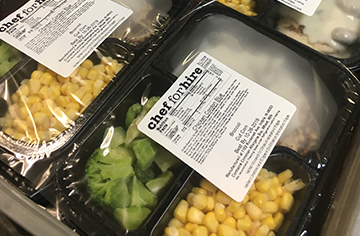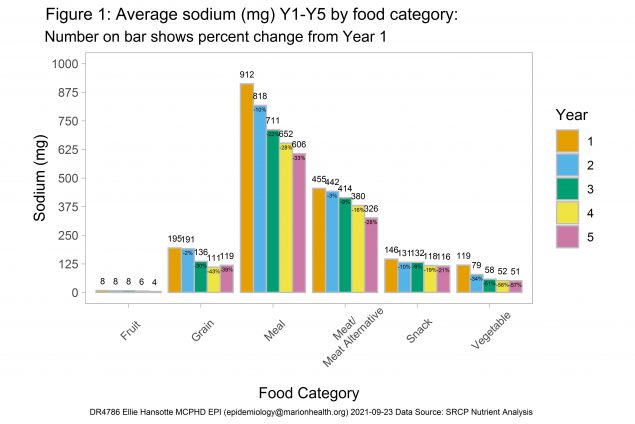Marion County Is Making Meals Heart Healthy for Children and Older Adults
Download the story [PDF – 654 KB]
Federal nutrition programs serve children and people with low incomes. Their goal is to increase access to food, foster a healthful diet, and provide nutrition education.1 Food service companies are partners in carrying out these programs. They often rely on processed and packaged foods because those products tend to be low cost and easy to prepare.
About 70% of sodium in U.S. adults’ diets comes from processed and prepackaged foods.2 Eating high sodium foods can lead to hypertension, also known as high blood pressure, which can cause heart disease or a stroke.
The Marion County Public Health Department in Indianapolis, Indiana, wanted to address the heart health of children and older adults experiencing nutrition insecurity. The department’s registered dietitians partnered with the Indianapolis Parks and Recreation Department (Indy Parks) and CICOA Aging & In-Home Solutions (CICOA), both of which provide meals to area residents, and with Chef for Hire, the company that makes the meals for both organizations.
Public Health Challenge
Nutrition security occurs when a person has regular access, availability and affordability of foods and beverages that promote well-being and prevent or treat disease. Without food and nutrition security, individuals are at risk for chronic diseases.3
Children who qualify for Indy Parks’ At-Risk After School Meals and Summer Food Service programs receive free and low-cost meals. Likewise, free and low-cost meals are provided to older adults who qualify for CICOA’s home-delivered, congregate, and voucher meal programs, which feed more than 9,000 participants every year.
Unfortunately, most products available to food service operators are high in sodium, which puts people at risk for poor health outcomes at greater risk.
Approach

Frozen meals provided by Chef for Hire, the food service provider, are distributed to CICOA Aging & In-Home Solutions adults by the meal voucher program.
Indy Parks and CICOA set out to lower sodium in the meals they provide by 20%. Program staff, registered dietitians from the health department, and the food service provider met to identify the meals and products that had the most sodium.
This group met with vendors to find affordable, lower sodium replacements. They held taste tests for program participants to be sure the lower sodium items were still appealing before making changes to the menus and recipes.
The county’s dietitians analyzed the meals over time to track progress in sodium reduction and held training sessions to teach partners how to promote heart-healthy food.
Results
he amount of sodium in each category of food provided by Chef for Hire to CICOA and Indy Parks went down by more than 20%, exceeding the goal. Sodium was cut by 28% in meats and meat alternatives and by 57% in vegetables. The percentage of lower sodium products being offered rose from 76% at the start of the project to 92% at the end. As an added benefit, replacing high sodium products with lower sodium ones fit within the programs’ budgets.
Lessons Learned
After working together for 5 years, the team learned several keys to success.
Communicate. The county’s registered dietitians built strong relationships and honest communication with partners, making sure that the sodium reduction goals did not conflict with other priorities, such as not raising the overall cost of meals.
Look for quick wins. The dietitians began by recommending simple ways to cut down on sodium, such as replacing canned vegetables with frozen ones and not adding salt when boiling water for pasta. Replacing the high sodium ingredients used in several recipes with lower sodium options also had a big effect. These quick wins helped partners see immediate results from relatively small efforts.
Take a stealth approach. People often believe that “lower sodium” means “less flavor.” Rather than telling participants about the efforts to reduce sodium, the teams took a stealth approach and held taste tests to be sure participants would like the food.
What’s Next
Indy Parks, CICOA, and Chef for Hire all remain committed to the goal of keeping sodium levels low in meals served to children and older adults.
- Partners continue to meet regularly to review foods and menu items.
- Indy Parks and CICOA now include sodium guidelines in their food service contracts.
- Chef for Hire adopted low sodium purchasing guidelines that the company shares with its vendors.
- CICOA set up a database that keeps track of the nutrient information on the current menu. The list will be updated as items, meals, and recipes change.
- CICOA added sodium education dissemination to the meal site staff’s performance reviews.
Find Out More
Learn more about the Marion County Public Health Department and Indianapolis, Indiana.
Learn more about the partners mentioned in this story, including CICOA and Chef for Hire.
Use the SRCP Implementation Guide to apply sodium reduction strategies derived from the SRCP into your communities.
References
- U.S. Department of Agriculture. About FNS. Accessed August 20, 2021.
- U.S. Food and Drug Administration. Sodium in Your Diet. Accessed August 9, 2021.
- U.S. Department of Agriculture. Key Statistics & Graphs. Accessed August 26, 2021.
- Gregory CA, Coleman-Jensen A. Food Insecurity, Chronic Disease, and Health Among Working-age Adults [PDF – 931 KB]. Washington, DC: USDA. 2017. Accessed August 20, 2021.

